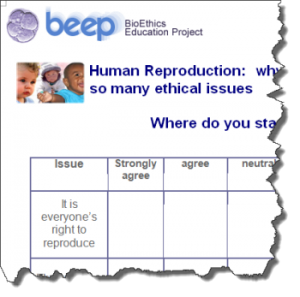Ethical issues in human reproduction: Difference between revisions
No edit summary |
No edit summary |
||
| (12 intermediate revisions by 5 users not shown) | |||
| Line 1: | Line 1: | ||
{{ResourcePageGroupMenu|BEEP}} | {{ResourcePageGroupMenu|BEEP}} | ||
{{Rinfo | {{Rinfo | ||
|subject= | |type= Lesson idea | ||
|attribution={{Jocelyn Wishart}} | |||
|subject= Science | |||
|resourcenumber= SC0013 | |resourcenumber= SC0013 | ||
|age= | |topic=Ethics, Human reproduction | ||
|age= KS5, Secondary | |||
|title= Ethical issues in human reproduction | |title= Ethical issues in human reproduction | ||
|content= | |tagline=Why does reproduction raises so many ethical issues? When does life begin? | ||
|format= A | |content= People have passionately debated this deceptively simple question through history. For some people, the answer is easy though this web tutorial aims to inform and encourage debate. A student's activity outline offers a table to record their personal views at the start and end of the session. A web tutorial offers information and three IVF case studies to discuss in small groups. Note that students may also check two other ORBIT resources [[Cloning]] and [[Designer Babies]] which you may choose to discuss separately, if at all possible. | ||
|strategy= | |format= A single page Word document | ||
|additional resources= | |image=Ethicalissues1.png | ||
|strategy= | |||
|Learning Objectives= | |||
* Being able to articulate and justify their opinions. | |||
* Listening to the views of others and consider them against their own. | |||
* Developing an increased understanding of bioethical issues in human reproduction. | |||
|additional resources= | |||
|useful information= | |useful information= | ||
|related resources=[[Cloning]], [[Designer Babies]] | |related resources=[[Cloning]], [[Designer Babies]] | ||
|other= | |other= | ||
|resources= | |resources= | ||
* The student activity outline 'Reproduction and Ethics': http://www.beep.ac.uk/content/352.0.html | |||
* The student information: http://www.beep.ac.uk/content/192.0.html | |||
* Toulmin's model: http://www.beep.ac.uk/content/284.0.html | |||
* Three family IVF case studies: http://www.beep.ac.uk/content/117.0.html | |||
* A blank teacher's planning proforma 'IVF: considering own and others' perspectives': http://www.beep.ac.uk/content/352.0.html | |||
[[File:Ethicalissues2.png|border|250x250px|link=|Preview of student start page]] | |||
|final=yes | |||
}} | }} | ||
[[Category:Secondary]][[Category:Science | [[Category:Secondary]][[Category:Science]] | ||
Latest revision as of 14:25, 2 February 2015
Lesson idea. People have passionately debated this deceptively simple question through history. For some people, the answer is easy though this web tutorial aims to inform and encourage debate. A student's activity outline offers a table to record their personal views at the start and end of the session. A web tutorial offers information and three IVF case studies to discuss in small groups. Note that students may also check two other ORBIT resources Cloning and Designer Babies which you may choose to discuss separately, if at all possible.
Teaching approach. This lesson outline stimulates A-level students to engage in discussion(ta), develop their reasoning(ta) skills and increase their awareness of the bioethical(topic) issues involved in human reproduction.
Background texts and open-ended questioning(ta) about human reproduction, contraception and IVF are provided as the stimulus. Small group discussion about these topics, writing on post-it notes, and reading case studies aim to get students reasoning(ta) to justify their opinions, and to compare and evaluate competing views. Finally, whole class(ta) discussion synthesises the emerging ideas and encourages students to consider changing their positions or adding additional issues to a recording table. (edit)
| Resource details | |
| Title | Ethical issues in human reproduction |
| Topic | [[Topics/Ethics|Ethics]], [[Topics/Human reproduction|Human reproduction]] |
| Teaching approach | [[Teaching Approaches/Questioning|Questioning]], [[Teaching Approaches/Whole class|Whole class]], [[Teaching Approaches/Reasoning|Reasoning]], [[Teaching Approaches/Discussion|Discussion]] |
| Learning Objectives |
|
| Format / structure | A single page Word document |
| Subject | [[Resources/Science|Science]] |
| Age of students / grade | [[Resources/KS5|KS5]], [[Resources/Secondary|Secondary]]
|
| Related ORBIT Wiki Resources | |
| Files and resources to view and download |
|


